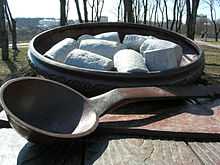Halušky
| Halušky | |
|---|---|
| Dumpling or noodle | |
 Bryndzové Halušky with bacon | |
| Main ingredient(s): | |
| batter (flour, water) | |
| Variations: | |
| Bryndzové halušky, strapačky | |
| Recipes at Wikibooks: | |
|
| |
| Media at Wikimedia Commons: | |
|
|


Halušky (IPA: [ɦaluʃkɪ], in Czech and Slovak; singular: haluška, Hungarian: galuska, Romanian: găluşcă, Serbian: galuška, Ukrainian: галушка, Lithuanian: virtinukai) are a traditional variety of thick, soft noodles or dumplings cooked in the Central and Eastern European cuisines (Slovakia, Czech Republic, Poland, Serbia, Ukraine, Romania and Hungary). Halušky can refer to the dumplings themselves or to the complete dish.
Preparation
The dumplings can be made from dough spread in a thin layer on a wooden cutting board, then cut and scraped off in small pieces which are dropped into boiling water. They can also be made with a special perforated halušky strainer forming small (1/2 X 2–3 cm) irregularly-shaped lumps which drop directly into boiling water as a thinner batter-like dough is pressed through the openings of the strainer.
Although recipes vary from region to region, in general flour is mixed with water to form a batter. Finely grated potatoes can be added to the batter. Eggs may be added but in Slovak Bryndzové halušky, egg is not used at all. Flour and mashed potatoes are enough to form a batter. After cooking, they are mixed with various ingredients such as cheese, meat, butter, cabbage, onions, or combinations of these.
Variations
Bryndzové halušky is a typical Slovak traditional dish also found in Moravia in the eastern part of the Czech Republic. In Hungary, galuska are often eaten with meat stews, such as goulash or pörkölt.
In the United States, most adapted halusky recipes call for egg noodles rather than potato dumplings. Some American cooks include loose, cut, and fried green cabbage (a convergence with strapačky, compelled by simplicity, difficulty in finding bryndza or acceptable substitutes, and access to affordable cabbage in areas with prominent existing Slavic and Germanic immigration).
Variations of halušky
See also
- Slovak cuisine
- Kluski, a Polish dumpling, part of Polish cuisine
- Passatelli
- Spätzle
- Gnocchi
External links
- Salaman, Rachel (2003). "Halušky: Humble King of the Slovak Kitchen". Spectacular Slovakia. Retrieved 2008-09-11.
- Salaman, Rachel (2003-01-20). "Halušky: Like gnocchi only smaller and tastier". The Slovak Spectator. Retrieved 2008-09-11.
- Reynolds, Matt (1999-06-21). "Three liters of bryndzové halušky small work for hefty men in national eating competition". The Slovak Spectator. Retrieved 2008-09-11.
| ||||||||||||||||||||||||||||||||||||||||||
| |||||||||||||||||||||||||||||||||||||||||||||||||||||||
| Wikimedia Commons has media related to Halušky. |